 Want to prepare for emerging social technologies and marketing tactics?
Want to prepare for emerging social technologies and marketing tactics?
Wondering how to reach your audience as algorithms change?
To explore the past, present, and future of social media marketing, I interview Brian Solis.
More About This Show
The Social Media Marketing podcast is an on-demand talk radio show from Social Media Examiner. It's designed to help busy marketers, business owners, and creators discover what works with social media marketing.
In this episode, I interview Brian Solis, a digital analyst and futurist at the Altimeter Group. He's considered one of the founding fathers of social media marketing. He authored The Social Media Manifesto and the book Engage. His most recent book is X: The Experience When Business Meets Design.
Brian explores the insights revealed in his most recent update to The Conversation Prism.
You'll discover how human aspiration and intent can help you reach your desired audience as social media continues to evolve.
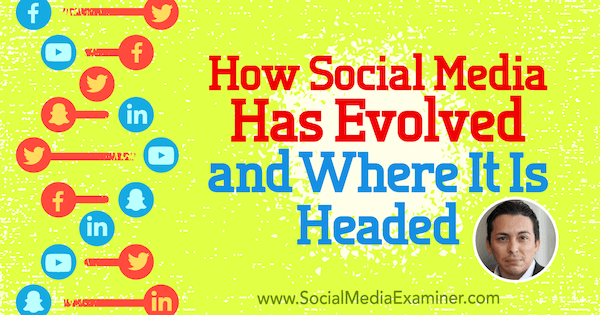
Share your feedback, read the show notes, and get the links mentioned in this episode below.
Listen Now
Where to subscribe: Apple Podcasts | Spotify | YouTube Music | YouTube | Amazon Music | RSS
Here are some of the things you'll discover in this show:
How Social Media Has Evolved and Where It Is Headed
Social Media in 2007
The early days of social media were a really exciting time, Brian explains. After Web 2.0 in Silicon Valley in the mid-2000s, Facebook opened to the public in 2006, Twitter appeared in 2007, and early social networks like Friend Feed and Friendster were still around. Some people saw the promise of social media but most of the world had no idea. There was zero direction. Social media was, and still is in some ways, the Wild West.
When Brian wrote The Social Media Manifesto, he was thinking about the idea of a revolution. Social media had the potential to be a great democratizer of information. Social media was a platform where everyone could share their voice.
As someone who struggled to get through to traditional media or buy media to reach people, Brian believed that the ability to reach people directly and people-to-people engagement were going to be the future of all media. Brian wrote the manifesto so individuals, marketers, brands, and traditional media would think about the potential and how to be part of the movement, rather than try to control it and broadcast through it.
Get World-Class Marketing Training — All Year Long!
Are you facing doubt, uncertainty, or overwhelm? The Social Media Marketing Society can help.
Each month, you’ll receive training from trusted marketing experts, covering everything from AI to organic social marketing. When you join, you’ll also get immediate access to:
- A library of 100+ marketing trainings
- A community of like-minded marketers
- Monthly online community meetups
- Relevant news and trends updates
At the time, Brian ran a couple of companies, including an early digital agency/lab dedicated to helping startups reach their markets.
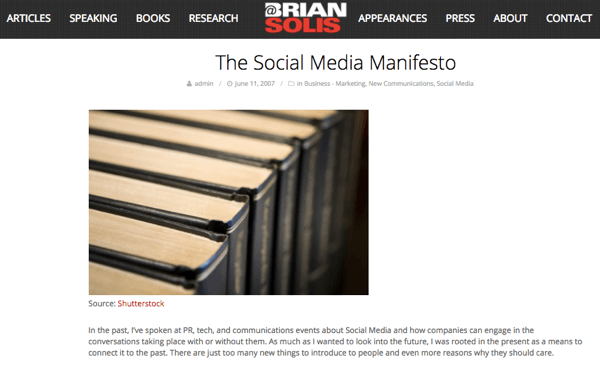
Using techniques that might be considered “growth hacking,” the agency found clever, nontraditional ways of helping companies with few resources get as big as they could so they could get acquired, make an IPO (initial public offering), or simply reach profitability. Brian was in and around the development of not only social media but also many other social technologies.
Brian says after the rise and fall of Web 1.0, Web 2.0 showed promise but was then hit with the economic challenge of the 2008 recession. However, Brian was interested in the way social media seemed almost recession-proof. It took everything by storm. For instance, South by Southwest Interactive enjoyed a surge in popularity around 2005 through 2007 with the rise of Web 2.0 and social media.
Plus, it was the beginning of entrepreneurship, at least in this era. Everybody in every industry was suddenly a social media pro. You had marketers, advertisers, coaches, you name it. Everybody latched onto social media because it seemed like it was the next gold rush.
Social media showed the promise of fantastic opportunities, not just from a market or a profit standpoint, but for changing the world. Brian wanted to do his part to steer social media in a positive and productive direction.
Listen to the show to hear more about the evolution of the Internet and social media.
The Conversation Prism
Brian started working on The Conversation Prism in 2007, and it officially launched in 2008 at South by Southwest with posters all around Austin.
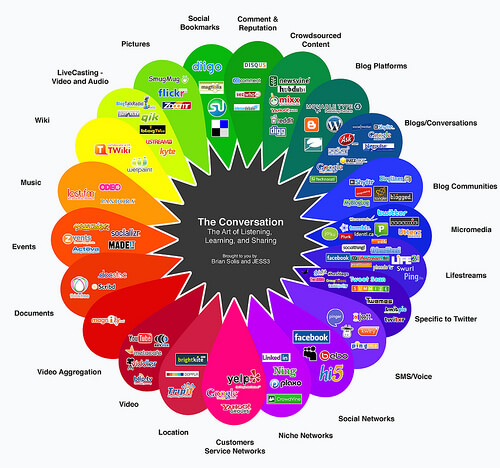
Brian created The Conversation Prism as a response to the hundreds of social networks popping up everywhere: Facebook, MySpace, Friendster, and all of these “niche works,” as they were called. Ted Rheingold started Dogster and Catster, which were social networks for dog and cat owners. Plus, people became “social media experts” overnight.
The Conversation Prism (along with The Social Media Manifesto) was Brian's attempt to explore and make sense of this seemingly chaotic landscape. Brian says the work was like digital anthropology. He wanted to organize all of the networks according to what they offered, their promise, and how people were using them.
At the center of The Conversation Prism was the idea that all of these things came together in some way, shape, or form. The map was also created so marketers, media outlets, and brands could see all of the social networks, think about how they were being used, and figure out how to listen to conversations and where to engage.
The early drafts of the Prism showed how one conversation could bend light and go everywhere. However, as the Prism added hundreds of networks, stacking them vertically became impossible. Instead, Brian tried to create a visual that was still true to the sense of a prism with spectra of conversations across the web, so he ended up organizing The Conversation Prism in a circular form.

When The Conversation Prism hit the market in 2008, it took off like crazy. Initially, The Conversation Prism was just a free infographic, but due to high demand, was later sold as a 22 x 28-inch poster. Marketers, brands, and entrepreneurs hung it up on their walls for inspiration.
The Conversation Prism also inspired a lot of platforms like Radian6 to create technologies that would allow people essentially to bring The Conversation Prism to life. They started a massive movement.
Listen to the show to hear Brian discuss the impact of apps and mobile on The Conversation Prism.
The Latest Conversation Prism Update
The Conversation Prism was recently updated for the first time in four years. During that time, Brian has been busy covering everything from digital transformation, corporate innovation, and customer and employee experience to corporate culture and disruptive technologies.
Since the last update, social media has found its stride. Instead of big disruption, many social networks came and went. Because many platforms were turning over quickly, he let the changes play out. Over the last year or so, Brian got really serious about the update. His friend Jaimy Szymanski helped with this version, in which they removed 84 companies and added 141.
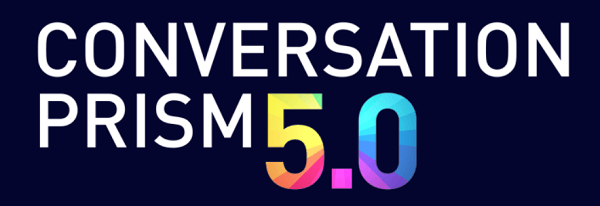
They also added new categories without taking any away. This change shows that social media is getting more sophisticated and expansive. For instance, they added messaging, as well as crowdfunding, and travel and hospitality, because social media is becoming more vertical. They also started to track connecting IRL, which are social networks (like Tinder), which bring people together in real life.
Listen to the show to hear Brian and I discuss one of the platforms that disappeared quickly.
The Rise of Live Video, Messaging, and More
I ask Brian for his thoughts on a variety of things related to social media in the next part of our conversation.
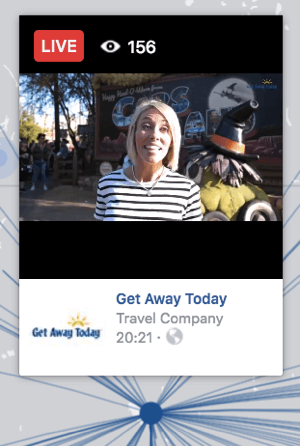
Live Video. Live video is the next iteration of how people share themselves, as well as how they watch or follow others. In the beginning, social media was largely text and then evolved into imagery, and later, more sophisticated imagery. Video started with YouTube, Vimeo, and other early networks. Now, live video has turned people into real-time broadcasters.
Many of these people simply share who they are and what they're doing right now. Or they use live video to share serendipitous moments. However, others use live video as full-on broadcast mechanisms to engage new audiences in ways that weren't possible before. These users are almost becoming like their own TV networks.
In some ways, people haven't been very creative in the way they use live video. But Facebook, for example, has started to show what's possible beyond Twitter, Periscope, and Meerkat. People can engage small or large groups around moments that matter.
Algorithms. There are algorithms, artificial intelligence, and what Brian calls “the human algorithm.” Algorithms are designed by different companies for different purposes. Companies need to consider the human algorithm (human aspiration and intent) in terms of purpose, outcomes, and possibilities.
Without a positive, optimistic approach, you can quickly steer people into a lot of trouble. Brian believes that by aligning artificial intelligence with the human algorithm, algorithms can be much more human, relevant, and promising.

Discover Proven Marketing Strategies and Tips
Want to go even deeper with your marketing? Check out the Social Media Marketing Podcast! Publishing weekly since 2012, the Social Media Marketing Podcast helps you navigate the constantly changing marketing jungle, with expert interviews from marketing pros.
But don’t let the name fool you. This show is about a lot more than just social media marketing. With over 600 episodes and millions of downloads each year, this show has been a trusted source for marketers for well over a decade.
I mention, as an example, how five years ago, National Geographic on a single post would get like 50,000 shares, millions of engagements, and tens of thousands of comments. Now their audience is substantially larger and they get maybe 1% of the engagement. I think algorithms are there to create a good user experience but have also dramatically hurt engagement and conversations.
When I ask Brian if algorithms have forced live video to be more necessary, he says yes and no. You need to consider the human algorithm element. Just because you have the platform doesn't mean that you're going to be engaging or sharable.
“With social media comes great responsibility and great opportunity,” Brian says. Broadcasting means you have to challenge yourself to think about whom you are trying to reach, why you want to be followed or watched, and what kind of content and engagement strategy you will build around it to be relevant. Then, to make sure you're plugging into the algorithms so you reach your desired audience, you need to assess how the algorithms work and how they're always changing.
Looking at The Conversation Prism 5.0 from the center outward, a content creator, consumer, brand, or marketer can see a framework for designing strategies for reaching the right people. Those algorithms should be considered as part of that strategy.
Live video goes back several years. The success of live video has depended not only on a platform but also on interesting, engaging content. Justin Kan's startup, Justin.tv, allowed people to live-stream their lives. Justin.tv has since become Twitch, which is live gaming. Justin.tv had to pivot because some people were broadcasting their lives because they could, and it wasn't really interesting. Another platform, Ustream, appeared after Justin.tv.
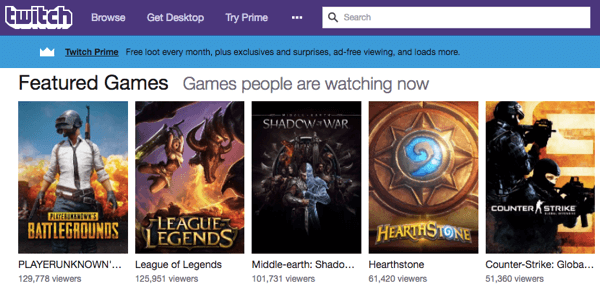
Facebook has really demonstrated what's possible because it's such a huge platform where people have a built-in audience. The algorithm will definitely affect who you do and don't reach. At the moment, Facebook is putting substance behind live, so now is probably the best time ever to get into live video.
Messaging. Messaging is the result of people's increasingly mobile lifestyle. Messaging and notifications have become massive and led to different types of messaging, such as Snapchat, not just texting. Similarly, Dave Morin, who was an early driver of Facebook, founded a great network called Path, which was about intimate, immediate social networking with the people who mattered in your world.
Although Path came and went, you can still find messaging that harnesses the private, public, and other types of moments. There's this famous saying, “You live a private life, you live a public life, you live a secret life, and there are networks for all of them.”
Augmented Reality. Augmented reality goes back to the early days of mobile. It allows you to add a layer that really brings the real world to life. People are doing this to some extent, just not in real time. For instance, in the early days of the iPhone, Brian and a friend developed technology for seeing enhanced information about products in-store. You could hold the phone over UPC codes in supermarkets, and product information appeared. QR codes also came out around that time, and others were experimenting with consumer applications, too.
Brian calls these types of programs “experience architecture.” That is, just because you can do it, doesn't mean it's necessary. However, you can find great augmented reality applications, one of which is the vertical windshield.
Social Television. Facebook Watch was just announced, while major companies including Snapchat, Twitter, and Apple are making huge bets bringing television to mobile and some of the social platforms.
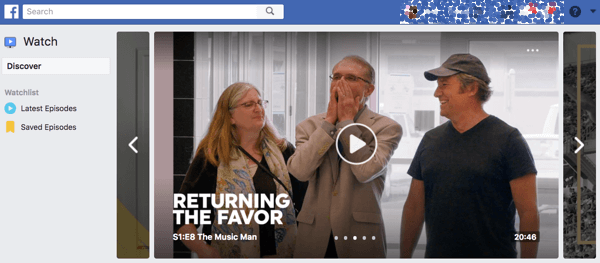
Social TV is the next big thing, Brian says. It was born out of what people did anyway: watching television and going on social media to participate in the conversation. Content playing directly on the network will further integrate the experience.
In early attempts, dedicated social networks had content as the mainstay, and people engaged around the content. However, better opportunities come when you engage with your social or interest graph and introduce content into that mix. Everybody's starting to bid on and create content. It's a matter of time until we start to see what Netflix, Amazon, and Apple create.
Determining Influence. Brian has been studying digital influence since 1997. Brian observed random people becoming incredibly influential, meaning they could have an effect or change behavior. Lots of tools can help you find great people. But like any data point, you get out of it what you put into it. You have to really be mindful of what you're thinking about so you can find the right people to be involved.
Artificial Intelligence. Anytime there's a new technology, marketing tends to put that technology in the portfolio of classical marketing. Brian has seen this with social media, the Internet of things, everything. He believes artificial intelligence isn't something that should simply be added to the mix.
Marketing is ripe for innovation and disruption. So much is possible when you start thinking differently about data, platforms, and opportunities. Artificial intelligence will make certain things better and traditional marketing even worse. To illustrate, an artificial intelligence platform called Kahuna plugs into marketing and can help you better understand how people consume content.
As long as people's minds are open to doing things in new ways, artificial intelligence will make this generation of marketers the most valuable breed. When individuals think differently about their approaches and build on that, that's when they win.

I read that IBM is partnering with MIT. IBM is investing heavily to build the next generation of artificial intelligence engineers. The ability to make sense out of data rapidly will be a huge competitive advantage.
It comes down to experience architecture, Brian says. People need to design new ways of doing or seeing things so the outcomes become wonderful experiences that people didn't know were possible. This field is for anybody who wants to re-create themselves as a relevant strategist or expert in the future.
Listen to the show to learn about the great unbundling.
Discovery of the Week
AFS, which stands for Advanced Facebook Search, is a cool Chrome plugin that suggests search options you can't even imagine are available, such as a page where someone is tagged or videos a person likes.
A while ago, Facebook beefed up its onsite search so now you can search for people, posts, photos, pages, groups, and so on. With the AFS plugin, you can dive even deeper into Facebook. It's like uncovering hidden advanced search features with an easy-to-use tool.
After you install the plugin, go to Facebook and start searching as you normally do. For instance, type the name of a person or a page. Then click the AFS plugin's browser icon to see extra-granular searches based on the search you just did.
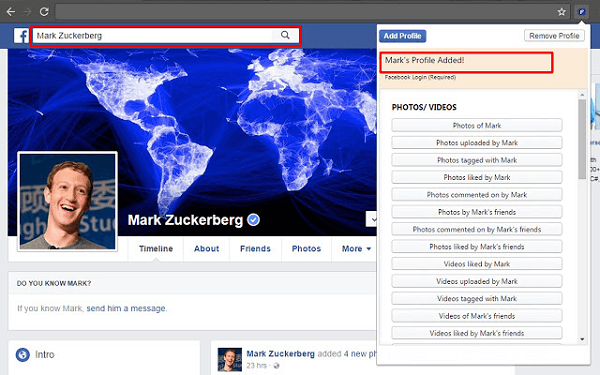
Social media marketers can use AFS as a research tool. You might see what's searchable on Facebook and maybe create content in that vein.
Find AFS in the Chrome Web Store.
Listen to the show to learn more and let us know how AFS works for you.
Listen to the show!
Where to subscribe: Apple Podcasts | Spotify | YouTube Music | YouTube | Amazon Music | RSS
Key takeaways mentioned in this episode:
- Learn more about Brian on his website.
- Download The Conversation Prism and get a poster.
- Check out The Social Media Manifesto.
- Take a look at the Altimeter Group.
- Read Engage and X: The Experience When Business Meets Design.
- Learn more about Web 2.0, South by Southwest Interactive, and Ted Rheingold who started Dogster and Catster.
- Explore Radian6.
- Check out Jaimy Szymanski.
- Learn more about Justin.tv, Twitch, and Ustream.
- Read about Path and the vertical windshield.
- Explore Kahuna.
- Read about IBM's partnership with MIT.
- Check out AFS, also known as Advanced Facebook Search.
- Watch our weekly Social Media Marketing Talk Show on Fridays at 10 AM Pacific on Crowdcast or tune in on Facebook Live.
- Learn more about Social Media Marketing World 2018.
- Download the 2017 Social Media Marketing Industry Report.
Help Us Spread the Word! Please let your Twitter followers know about this podcast. Simply click here now to post a tweet.
If you enjoyed this episode of the Social Media Marketing podcast, please head over to iTunes, leave a rating, write a review, and subscribe. And if you listen on Stitcher, please click here to rate and review this show.
What do you think? What are your thoughts on the evolution of social media? Please leave your comments below.
Attention Agency Owners, Brand Marketers, and Consultants

Introducing the Marketing Agency Show–our newest podcast designed to explore the struggles of agency marketers.
Join show host and agency owner, Brooke Sellas, as she interviews agency marketers and digs deep into their biggest challenges. Explore topics like navigating rough economic times, leveraging AI, service diversification, client acquisition, and much more.
Just pull up your favorite podcast app, search for Marketing Agency Show and start listening. Or click the button below for more information.

